Pioneering Flights
-
Barnard, Charles Douglas
Capt Charles Douglas Barnard
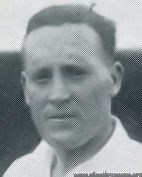 photo: 1930
photo: 1930Personal pilot to the Duchess of Bedford, 'ribald and golden-haired'.
b. 8 Dec 1895 in London; his father, Charles Gilbert Barnard, was a master printer (and not related to Franklyn Barnard's father). He learnt to fly in 1915 with the RFC. After WWI, became a test pilot for Sopwith, then a pilot with the de Havilland Airplane Hire Service after meeting Alan Cobham, then their chief pilot, in Spain.
In July 1920, he was convicted of manslaughter, for killing an elderly man in a car accident in which he failed to stop, and didn't report; "Charles Barnard (24), a demobilised airman from Watford whose machine was brought down in flames in France, was charged with the manslaughter of Alfred Sharp on the night of May 2, by knocking him down whilst driving a motor-car. A button, answering the description of other buttons from the deceased's coat, was found between the bonnet and mudguard of the accused's car. He was remanded, bail being refused." It also turned out that his driving licence had lapsed at the time, and he hadn't renewed it until some days after the accident.
He was given 4 months imprisonment in the 'Second Division' (such prisoners were kept apart from other classes of prisoners, received more frequent letters and visits and wore clothes of a different colour). The Judge said there was "too much reckless driving by people who served in the war. Their war services were no consolation to bereaved relatives."
Settling down a bit after that, he was the pilot in 1923 when an aeroplane belonging to the de Havilland Hire Service was used to ferry Commander Bristow to have a look at an Italian ship, the D'Aosta, which had become stranded in Malta. It was the first time the flight had been made, and it took over 14 hours, mainly (Charles complained) because the authorities in Pisa insisted on a deposit of 15% of the value of the machine.
One of his other jobs for the de Havilland Hire Company was to fly G-EBGT 'Nulli Secundus', a perfectly good D.H.9c, while a certain Captain Spencer jumped out of it - see the video here.
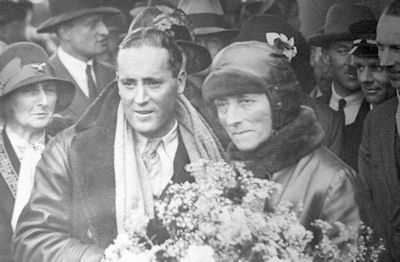
His first long-distance flight with the Duchess of Bedford was a tour in 1927 from her home in Woburn Abbey to France, Spain and North Africa, covering 4,500 miles in 3 weeks. Two years later, he piloted her Fokker monoplane, the 'Spider' to India and back, 10,000 miles in 88.5 hours; the RAeC gave him their Gold Medal for the year. It wasn't their first attempt at the flight to India and back - a year before they had tried the same thing, but problems with the propellor meant that the Duchess had had to come back by steamer from Karachi (which at the time was in India, of course).
In 1928, described as a 'flying man', he was cited as the co-respondent in a divorce case. At the time, he and Mrs Melita Erna May were living together at his place in Monmouth Rd, Bayswater; they got married in December.
In 1930 he and the Duchess made another record flight from London to Cape Town and back, 19,000 miles in 20 days, and he again flew to Malta and back in Puss Moth G-AAXW in 2 days: see the videos here :http://www.britishpathe.com/video/to-the-cape-and-back-in-19-days and here: http://www.britishpathe.com/video/malta-and-back-in-2-daysIn 1931, he was seriously injured when he, Lord Lovelace and their American mechanic crashed near Tripoli, as they were flying to Kenya.His marriage didn't last; Melita left him in 1933 and filed for divorce. He was in court again, when he was accused of assault by Mr Thomas Birks, a solicitor's clerk. Charles, described as a 'civil pilot wth a distinguished record' tried to persuade his wife to return to him, and somehow thought that a revolver might help; Mr Birks tried to intervene, and alleged that Charles fired a shot at him. Charles, however, won the case and was awarded 15 guineas damages (although he had asked for 50).He then formed his 'Flying Circus' - 8 aeroplanes which toured India in 1933 "giving displays of formation and stunt flying to over a million people who have never seen such a thing before... Joy rides will be offered to people at a small charge".He was back again by popular request in 1935, as co-respondent in yet another divorce case - this time with Mariska Marguerite Spurr.d. August 7, 1971. Only 2 people went to his funeral... -
Batten, Jean Gardner
Jean Gardner Batten
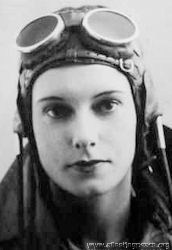 in 1930
in 1930b. 15 September 1909 in Rotorua, New Zealand, a "shy, determined girl".
"By the time I was nineteen I knew my future must be in flying." Studied music from a young age but, having passed the Royal Academy of Music Finals, she sold her beloved piano to get to England and pay for flying lessons.
One of the most spectacularly successful aviators of the early 30s; after her solo flight from England to Australia in 1934 (at the third time of trying) the New Zealand Govermnment awarded her £500 in recognition of her feat. She was in Melbourne a few months later to greet Scott and Campbell Black as winners of the MacRobertson Race, and left Sydney the following April to fly back to England, but didn't quite beat her record.
In November 1935, came her real breakthrough: she flew to Brazil and beat the South Atlantic crossing record, taking 13 hrs 15min in her Percival Gull.
This time, she was awarded:
- the Order of the Southern Cross (by the Brazilians);
- the Gold Medal of the French Academy of Sports;
- the Brittania Trophy (by the Royal Aero Club);
- the C.B.E. for 'general services to aviation';
- the Legion d'Honneur (the French seemed to like her, for some reason);
- the Johnson Memorial Prize (from the Guild of Airline Pilots and Navigators), and
- she was guest of honour in Paris at the Aero Club de France.
In October 1936, having attended literally dozens of receptions and award-giving ceremonies, she set off once more, this time to fly to New Zealand in her Percival Gull. On the way, she beat Harry Broadbent's record solo time to Australia, despite a puncture in the tail tyre which a helpful aerodrome official repaired by stuffing it with face sponges.
Just as Scott and Guthrie were returning rather sheepishly from the miserable Schlesinger Race to Cape Town, Jean was getting ready to fly from Australia to New Zealand. She arrived there on October 17th, met by large and enthusiastic crowds; the first woman to cross the Tasman Sea, the first direct flight from England to New Zealand.
On the last day of 1936, however, Jean's South Atlantic record was beaten by another woman - Mme Maryse Bastié.
In 1937, Jean again won the Brittania Trophy, the Harmon Trophy, and the Segrave Trophy for her 1936 flight. In October she set off for England again; at one stage, she was heading west, trying to beat Harry Broadbent's record, as Harry Broadbent was heading east, trying to break her record. She won; Jean beat Harry's record, while he had to give up at Basra. "I confess I am fed up", he said...
Jean picked up yet more awards; the Gold Medal of the Royal Aero Club; the Gold Medal of the F.A.I. (no less); summoned to Buckingham Palace to meet the King and Queen of the Belgians (exciting); immortalised in Madame Taussaud waxworks (until they melted her down, at least), another round of receptions as guest of honour...
But her brief time in the spotlight was coming to an end. Harry Broadbent took back his Australia-England record; Arthur Clouston and Victor Ricketts more than halved her England-New Zealand record time in 1938. She still attended dinners and receptions in her honour; she wrote her autobiography (called, rather disappointingly, 'My Life'), but she made no more record attempts. Even so, her remaining record, solo to Australia, stood for over 40 years.
In WWII she toured the country as part of the 'Wings for Victory' campaign, giving dozens of lectures anywhere between Manchester and Penzance.
Her Percival Gull, G-ADPR 'Jean' was presented to the Shuttleworth Trust on 26 April 1961, having been requisitioned by the RAF in WWII and then returned to Hunting Aircraft. However, by 1969 it needed major repairs and was grounded until 1978. Jean herself offered to come back from Tenerife to help: "I used to be quite good at stitching canvas on wings". It was sold in the early 90s (when Shuttleworth was strapped for cash) and is now on display at Aukland Airport:
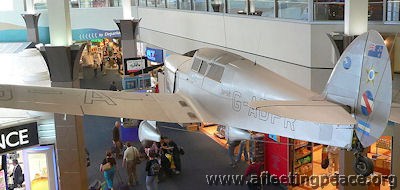
In 1980 she and Edgar Percival were made liverymen of the Guild of Airline Pilots and Navigators, and she then travelled to Hull to open the 'Silver Wings' exhibition, in honour of Amy Johnson.
Jean Batten owned:
a 1929 DH.60G Gipsy Moth, G-AALG, which she flew to New Zealand in 1933;
a 1929 DH.60M Moth, G-AARB, in which she broke the England-Australia record in 1934, and was later owned by Gabrielle Patterson, R Gordon and BK Lyall (simultaneously, that is), and later,
a 1933 DH.60G III Moth Major, G-ACKF.
She died in 1982 in Majorca.
-
Bentley, Richard Read
Richard Read Bentley
 in 1917
in 1917b. 20 November 1897 in London Dick described himself as "one who preferred to live in the open, rather than within the confines of a London office" - one who, luckily, found it possible to make his living mainly by aviation.
His mother having died when he was 12 (he said "I did not then recognise that my father was a broken man due to the loss of my mother"), he and his father had to move from Sheen Gate Mansions to a boarding house in a less fashionable area of London. After a while in an office in a paper merchant's - which he hated - he was packed off to Canada; when he got there, he found that his father had also died.
After a stint as a farm hand in Canada, he came back to England and joined the RFC in WWI (photographic reconnaisance with 59 Sqn, then a flying instructor at Hooton).
Then,"I hung around in London trying to get a job without any luck, like hundreds of other demobs. As I didn’t want to return to Canada I decided to try Rhodesia." He soon fell under Africa's spell, and for quite a long time lived in the jungle and went from job to job, supported by his dwindling RAF gratuity.
He then had "four marvellous years" after joining the South African Air Force - "Whoopee!!! Back on a job I really knew".
When the D.H. Moth first went on sale in 1926, Dick immediately decided he wanted to fly one from London to Cape Town. He raised the £600 he needed from the Johannesburg 'Star', in return for exclusive publicity, and on the 1st September 1927 set out from Stag Lane in G-EBSO, carrying a Mauser pistol generously lent to him by his C.O. Sir Pierre van Rynefeld. Lady Bailey had christened the aircraft 'Dorys', after Dick's then-girlfriend (later his wife), and you can even watch Lady B do her stuff here.
After a "trouble-free" flight, he arrived in Cape Town on the 28th September, completing the first solo flight in a light aircraft from England to Cape Town (and the longest single-engined flight to date, for which he got the RAeC's Britannia Trophy).
The 'Star' unexpectedly presented him with the aircraft (the the original deal was that it would be sold) and he then made his living from air taxi and joy-riding flights. In 1928, he escorted firstly Lady Heath, then Lady Bailey across the Sudan in their record-breaking flights (them women weren't trusted to fly alone, of course).
He and Dorys flew back to England for their honeymoon and then spent a few months at Hooton. On the way back down to Cape Town (yes, again), they met up with Glen Kidston and Donald Drew, who were using a Fokker triplane to do 'aerial safaris'; they offered to give Dorys a lift so that Dick's plane could carry a spare propeller for Stanley Halse's plane (I know this is all very complicated, I'm trying my best). Anyway, the Fokker made a forced landing and Dorys bumped her head quite badly, but was apparently OK. Dick later said that "I have said “apparently” because twenty years later - we had parted in 1938 - in 1948 she died in America of a haemorrhage of the brain. Could that blow received in 1928 have been the root cause of her demise?"
The flying world grew steadily and Dick soon became a ubiquitous figure on the civil aviation scene. "Popular, energetic, resourceful, he was as indifferent to the weather as to the day of the week, joining in the harum-scarum adventures of customers, welcome everywhere.” He flew the Shell Comper Swift G-ABUS, and his aerobatic displays were memorable.
He flew in the RAF(VR) in WWII, remarried (to Anne), then retired.
Dick died in May 1990, aged 93.
All quotes shamelessly lifted from Roma Part's 'Pioneering Spirit', which is on the Johannesburg Light Plane Club's website www.jlpc.co.za
-
Brook, Harold Leslie
Harold Leslie Brook

b. 11 October 1897, in Bradford
Only learnt to fly in 1933, and just scraped up the minimum 100hrs solo flying time required to enter the Race. The aircraft was barely ready in time either; a month before the start it didn't have any seats, and was in "a very unfinished condition". Harold was not impressed by "those fools at Reading [i.e. Miles Aircraft]... this is not the first time they have omitted to do something".
In March 1934, he tried to break the England-Australia solo record (held by CWA Scott) but only got as far as the Cevennes before crashing into one of the large mountains they have there. To give him his due, he picked up the important bits of his aeroplane, brought them back and used the engine in this Miles Falcon.
In 1935, after taking part in the MacRobertson, he flew back from Australia in record time; you might like to see him talk about his record-breaking flight (on the other hand, you may have some drying paint that needs watching); if so, click Record Flight From Australia - British Pathé (britishpathe.com)
Two years later, he added the Cape Town record. Mercifully, there don't appear to be any interviews about this one.
Pilot Officer in the Administrative and Special Duties Branch in May 1940, then briefly (28 Oct 1940 - 3 May 1941) in the Air Transport Auxiliary (ATA)
And, despite what you may read or hear, was never an accountant in his life (although with his spectacles on, he did rather look like one, and when he talked, he did rather sound like one [sorry]), and he signed himself 'Brook', not 'Brooke'.
But 'e were definitely from 'Arrogate.


H. L. BROOK writes to TERRY'S
Dear Sirs,
I should like to take this opportunity of congratulating you on the excellence of your Springs in my Gipsy 6 Engine. In a record-breaking flight of this description the engine has to be run for long periods in extreme temperatures, and at a higher rate of revolutions than normal, and for a valve spring to break would spell disaster. I had never at any time any fear of this happening with your springs, and they are now at the end of the flight in just as good condition as they were at the start.
Yours faithfully,
(signed) H. L BROOK.
'Flight'
Racing No. 31—H. L. Brook, and —?
And speaking of Bradford, here is Harold Leslie Brook, who was born there in 1897, and now resides in Harrogate. He joined the Royal Field Artillery on August 20, 1914, at the age of 16, obtained his commission soon afterwards, and, despite a couple of wounds, served five years in France and India.
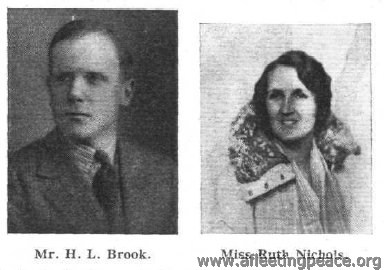
Restored to his family, he remained a normal civilian until Yorkshire began to build and fly sailplanes and gliders. These occupations kept him mildly diverted until the approach of his 37th birthday. Then he began to yearn for horse-power. The York County Aviation Club at Sherburn-in-Elmet offered a likely fulfilment of this secret ambition. So, in August, 1933, Brook placed himself in the hands of Instructor Cudemore, and after four hours' instruction became a soloist with serious designs on the MacRobertson Handicap, for which Phillips and Powis have built him the first of their Miles 'Falcons'.
What happened between last autumn and this spring is now almost historic. Brook bought the "Puss Moth" (Heart's Content) in which the Mollisons had crossed the Atlantic, and, with a total of 43 hr. in his logbook, pushed off solo from Lympne to survey the route to Melbourne. That was on March 28, 1934, at 5.20 a.m.
By noon the incident had closed. Describing it a few days later Brook said that, while flying through very dirty weather over France, he was forced down from 12,000 ft. by ice formation on the wings, and, before he knew how or why, the side of an unsuspected mountain was rushing up at him out of the murk. Guided by some uncanny sixth sense, he brought off a bloodless landing on the mountain proper. The scene of this epic of the air was Genolhac, in the Cevennes. With some local help he salvaged the "Gipsy Major," brought it back to England, and has had it installed in Heart's Content II.
Brook's next attempt on the Australian record will not be solo. If expectations are realised, he will be accompanied by two lady passengers.
'Flight'
Another England-Australia attempt
MR. H. L. BROOKE, a member of the York County Aviation Club, left Lympne at dawn on the morning of Wednesday, March 28, on an attempt to break the record for the England-Australia trip held by Sir Charles Kingsford-Smith with the time of 7 days 3 hours. Mr.Brooke was flying the " Puss Moth " (" Gipsy III ") Heart's Content, in which Mr. J. A. Mollison made an Atlantic crossing. A few hours after leaving Lympne, while flying through fog, he crashed in deep snow near Genholac, in the Cevennes. The machine was completely wrecked, but Mr. Brooke escaped with nothing worse than some bad bruises. For five hours he wandered about inthe mountains, and eventually found a small village, where he was given every attention. Later he returned to the wreck of his machine, and removed the instruments and other articles of value.
'Flight'
April 4, 1935
YORK COUNTY AVIATION CLUB, SHADWELL, LEEDS
During March the York County Aviation Club, Ltd., flew 63 hours at Sherburn-in-Elmet, and Miss Maurice and Mr.Pilkington made first solos. Two machines flew to Nottingham for the club dance, and Mr. Humble, the honorary instructor, has presented the club with a fire tender—a very apposite gift! The next dance will be held on April 13.
Mr. H. L Brook, who has just broken the Australia-England record with a Miles " Falcon," was trained at Sherburn—which appears to be a pretty good advertisement for the instruction.
'Flight'
These days, the home of Sherburn Aero Club: http://www.sherburn-aero-club.org.uk/
SWIFTLY from AUSTRALIA
How H. L. Brook, in a " Gipsy "-engined Miles "Falcon" broke the Solo Record : His Story in an Interview with " Flight
"LAST Sunday afternoon, at 3.55 p.m., the original Miles" Falcon " landed at Lympne, having flown in 7 days•* 19 hr. 50 min. from Darwin, North Australia, withMr. H. L. Brook, of Harrogate, at the controls. The •pilot thus beat the unofficial " s o l o " record of Mr. C. J.Melrose by 13 hr. 10 min., and the officially recognisedperformance of Mr. J. A. Mollison by 1 day 2 hr. 25 min.The shortest time for the Australia-England trip is still,of course, the 6 days 16 hr. 10 min. of Cathcart Jones andWaller in a " C o m e t ."After leaving Darwin at 5.30 a.m. on Sunday, March 24(Australian time), Mr. Brook's time-table was as follows:—Sunday night, arrived Rambang ; Monday, Penang; Tuesday,Rangoon; Wednesday, Calcutta; Thursday, Karachi; Friday,Athens; Saturday, Rome; Sunday, Marseilles (9.25 a.m.) ;Lympne (3.55 p.m.).the Timor crossing, he told a member of the staff of Flight,was " r o t t e n , " with rain, low clouds and heavy head winds.On the trip from Penang he landed on the delta near Calcutta.Over the Sundarbans low clouds and darkness caused him totake this measure rather than to fly on, possibly missingCalcutta, and, as he put it, perhaps making a crash landingthrough shortage of petrol.Perhaps the worst section of the trip was that betweenAthens and Rome, particularly the portion over the channelof Corfu, where a gale was encountered. At Brindisi Mr.Brook was advised not to proceed, but he pushed on andcrossed the Apennines in a snowstorm.And what of the man himself? He is a thirty-eight-yearoldYorkshireman, who, despite the newspaper stories, hasnever been an accountant in his life. When he was youngerhe indulged in motor racing and later built a few sailplanesand gliders. Then he joined the York County Aviation Cluband went solo after four hours' instruction. He next boughtMr. J. A. Mollison's "Puss Moth" Heart's Content, and setout for Australia to survey the route to Melbourne, for he haddecided to enter the MacRobertson Handicap. But ice formationforced the " Puss Moth " down on a mountain side inthe Cevennes. Neither Brook nor the "Major" (which, itshould be remembered, had already been flown over the SouthAtlantic) was rendered hors de combat, however. The enginewas salvaged and Brook brought it back to England, where itwas installed in the first of the Miles " Falcons" which thenwas fitted with extra tanks for the race. During the event itcarried a lady passenger and a large helping of appalling
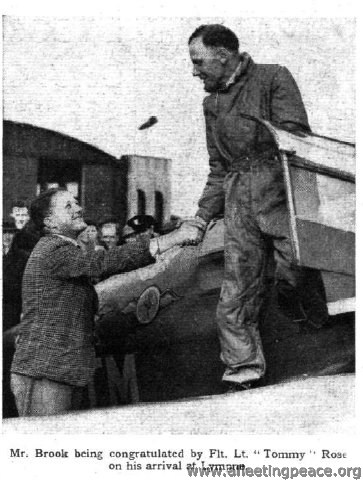
luck (no connection is suggested between the two facts!).Suffice it to say that the Australian trip, a large portion ofwhich was made in easy stages, took about twenty-six daysDuring his stay "down under," Brook worked until the" F a l c o n " and its engine were in tip-top condition beforestarting his almost unheralded flight.Of travelling in the "Falcon " he says that, compared withflying in an ordinary aeroplane with open cockpits, it was" like travelling in a saloon car instead of on a motor cycle. The veteran "Gipsy Major" was run throughout the flight at 2,100 r.p.m.
HILLSON PRAGA
Imported specimen 107 Praga E.114 OK-PGC. Regd G-ADXL (CofR 6479) 27.11.35 to F Hills & Son Ltd; dd Speke to Barton 30.12.35. CofV 91 issued wef 27.2.36. Dd 20.4.36 to Harold Leslie Brook; flown by him to South Africa, departing England 6.5.36; arriving Cape Town 22.5.36. Regn cld 6.36 as sold. Regd ZS-AHL 6.36 to OG Davies, Cape Town. Sold 8.37 to H Cooper, Cape Town. Converted to glider at Youngsfield 9.53.
30th Aug. 1940.
ADMINISTRATIVE AND SPECIAL DUTIES BRANCH.
The undermentioned are granted commissions for the duration of hostilities as Pilot Officers on probation:— 22nd May 1940.Harold Leslie BROOKE, D.C.M. (84353).
-
Broome, Frank Crossley Griffiths
Capt Frank Crossley Griffiths Broome 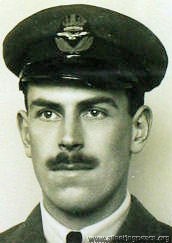 photo: 1917, when a Lieutenant in the Army Service Corps, aged 25
photo: 1917, when a Lieutenant in the Army Service Corps, aged 25Vickers test pilot - he and Stanley Cockerell (q.v.) were known as the 'Heavenly Twins'; Frank served under Stanley in WWI; when Frank married Miss Ismay Lermitte in Colchester in 1920, Capt. S. Cockerell, A.F.C., was best man. He and CJQ Brand were in the same squadron in WWI.
In 1920 the Heavenly Twins were the pilots of the attempt, organised by The Times, to make the first flight from Cairo to the Cape. The Vimy Commercial aeroplane left Brooklands on January 24 but crashed at Tabora [Tanganyika] on February 27. They finally reached the Cape "after a series of undeserved misfortunes".
Frank Crossley Griffiths Broome - born in London (St Pancras) in 1892. He enlisted in the Army Service Corps. Won DFC, and AFC.Youngest son of Frank Broome, and lived at Winterbourne, Weybridge.He married Ismay Lermitte, daughter of Lt Col Lermitte (deceased) of Woodhouse, Great Horkesley at All Saints Church on August 17th 1920.At the wedding ceremony, the cake was adorned with the silver Vickers Vimy, which had been presented to him by The Times newspaper, to commemorate his 1920 Africa flight (in Silver Queen II) The purpose was to test the feasibility of the Cape to Cairo route, and was sponsored by the newspaper. The plane crashed, and it sounds as though the expedition was an arduous one.
Later the same crew of Captain Cockerell, Captain Broome and ex Sgt Major James Wyatt crashed in a seaplane in March 15th 1922, about four miles from Hastings.
Broome also flew with 112 Sqn, based at Throwley. On the night of 19/20 May 1918, he was one of dozens of pilots that took off against a wave of Gothas and Giants which attacked the UK. Broome didn't see them, but fellow sqn pilot CJQ Brand bagged a Gotha that night. -
Butler, Alan Samuel
Mr Alan Samuel Butler J.P. 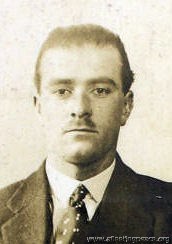
photo: 1921, aged 23
Chairman of de Havilland; the story goes that in 1921 he asked the one-year old de Havilland Aircraft Company to build a fast two-passenger touring aeroplane to his specification,
and stumped up £3,000 for them to do it. The money saved the company from extinction and they appointed him to the board of directors forthwith. He held the position until he retired in 1950.
The aeroplane became the DH37, (which he named, firstly, 'Sylvia' after his sister, then, rather diplomatically, 'Lois', after his wife, q.v.), which he entered in the very first King's Cup Race in 1922 and again in 1924, coming third.
He and Lois set up a world speed record of 120mph for 1000 km in 1928, and they also flew to Cape Town together .
Entered the MacRobertson Race in 1934 (assigned No 59) but didn't take part.
Was still aviating in 1970.
-
Cathcart Jones, Owen
Lt Owen Cathcart Jones

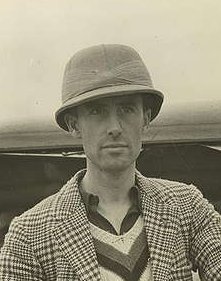 1934
1934 Born 5th June, 1900, London (definitely not Canadian, despite some nasty rumours).
McRobertson Centenary Gold Medal 1934
Royal Aero Club Silver Medal 1934
Holder of 8 Long Distance World Records. 1934
It's difficult to know what to make of Owen Cathcart-Jones, really; he was handsome, adventurous, undoubtedly talented, and clearly an excellent aviator - but, I'm afraid, rather prone to go 'AWOL' - both in his personal and service life!Born in London on 5 June 1900, he joined the Royal Marines in 1919, then, after the usual period of general service he volunteered for flying and joined R.A.F Netheravon on 12 January 1925, in the first batch of Marines officers to be transferred.
He was awarded his 'wings' in August 1925 and was posted to RAF Leuchars, serving with 403 Flight on HMS Hermes, and 404 Flight on HMS Courageous, taking a hand in the troubles in China in 1926-27 and again in Palestine in the following year.
In 1927, he wrote to The Times:
Sir,
On July 17 I had occasion to be flying down the east coast of Greece, and when in the vicinity of Mount Kissavos, near Larisa, I was astonished to see a large golden eagle fly past my aeroplane on a parallel course at a distance of about 80 feet away. The bird did not appear to be at all concerned at the noise of the engine, and in fact turned its head round to look at the aJrcraft on passing. The speed on my indicator showed 70 knots, and the height by my altimeter was 4,000 feet. Judglng by the speed at which I was passed by this bird, I should estimate that it must have been travelling at 90 mp.h.; which I consider to be quite a phenomenal speed for such a large bird at that high altitude.
Yours faithfully,
OWEN CATHCART-JONES,
Lieut. H.M.S. Courageous, at Skiathos, Greece, July 22.
which prompted Mr Seton Gordon, from the Isle of Skye, to reply:
Sir,
The letter from Lieutenant Owen Cathcart-Jones in The Times of July 27 which describes the great speed of a golden eagle in flight is of interest to me, as I have for some time believed the eagle to be one of the fastest birds. On one occasion I satisfied myself that an eagle was travelling at a good 120 miles an hour - probably much more -but then the bird was rushing earthward from a considerable height, and Lieutenant Owen Cathcart-Jones's bird was apparently on a level course. Little is definitely known even to-day as to the maximum speed any bird is capable of. Not so long ago a senior officer of H.M.S. Hood told us that when the Hood was steaming 34 miles an hour into a 15-mile-an-hour wind a formation of guillemots had no difficulty in forging ahead and crossing the vessel's bows. This interesting record shows that even the humble guillemot is capable of an air speed of well over 50 miles an hour, so a speed of 90 m.p.h. is not surprising in a bird of the wing power of a golden eagle.
I am, &c.,
During this time, he met Audrey, the wife of Captain Hugh Fitzherbert Bloxham, late of the Indian Army, then a Colonial Office official in the Prison Department at Hong Kong. Hugh and Audrey had married in St John's Cathedral, Hong Kong, on 6 August 1925.
Clearly Owen and Audrey got along rather well, and in November, 1927, their daughter Imogen was born.
Hugh duly sued Audrey for divorce in May 1928, "on the ground of her adultery, at the Hotel Savoy, Hong Kong, with Lieutenant Owen Cathcart-Jones, of the Royal Marines." The petition was uncontested.
On 12 Aug 1929 in Malta, Audrey had a son, Anthony.
"He established a reputation as a forceful and daring pilot, and one of his escapades became the talk of the Fleet; on 22 Aug 1929 he was on exercises with the Fleet and loaded his plane with a large packet of "service brown" toilet paper intending to drop it on H.M.S. Revenge which should have been last in the line. Unfortunately the C-in-C had inverted the line and he dropped the "bumph" very accurately on the Flagship, H.M.S. Queen Elizabeth. His Flycatcher aircraft was clearly numbered "7" and the Captain of H.M.S. Courageous was called to the Flagship on return to harbour to explain. Cathcart-Jones duly appeared before the Admiral with his reasons in writing [he made up some nonsense about it acting as a 'sighter' for actual bombs] and had to be on his best behaviour for some time."
On 26 November 1929 he made the first ever night deck landing in a fighter aircraft, flying a Fairey Flycatcher from H.M.S Courageous.
"It is a reminder of our one time presence in the Middle East that his record shows his Flight carrying out patrols in Palestine, and the Courageous Flights being shore based at Gaza and Aboukir in 1929 during the 'Civil War'.
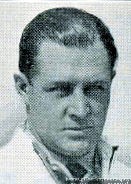
During his Fleet Air Arm service he became very friendly with a wealthy Naval Officer, Glen Kidston, with a similar passion for flying. Kidston was himself leaving the Navy and Cathcart-Jones decided that it was time to do likewise and to transfer his interests entirely to civil flying. He went on to half pay on 17 Febuary 1930 [for 6 months], joined National Flying Services Ltd. and never returned to the Service.
Audrey, by then aged 28, with Imogen (aged 2) and Anthony (aged 1) sailed from Brisbane to Plymouth on the P&O steamship Ballarat, arriving there on 21 Jan 1930.
On 21 April 1930, National Flying Services held their first display at Hanworth Park; Owen provided the finale by bombing a level crossing to bits. However, the meeting was not a success; "for some reason N.F.S. shows do not appeal to the average private owner" and crowds were poor.
In September 1931 he flew a D.H. Puss Moth, with Audrey as passenger, in the Deauville-Cannes Air Rally. After lunch and a gala dinner, they flew on to Cannes, despite a forced landing in the Alps when the fuel pipe and filter were found to be blocked with sand.
By the following May (1932), business was better; "taxi work is now on the increase and the N.F.S. pilots have been kept busy flying to places as widely separated as Plymouth and Berlin". Owen piloted G-ABTZ, a Stinson Junior belonging to Mr. E James, on several flights. On 31 July 1932, Audrey went on a conducted tour organised by NFS, of "eight Moths, one Bluebird and one Alfa Romeo", to Ostend.
Owen and Audrey lived in Tudor Court, Hanworth, London until 1934, but then Owen moved out, leaving her and the two children, who relocated to Wavenden, Bucks. In company with Kidston he broke 8 World records for long distance flights in 1934, including England to South Africa in a Lockheed Vega:

but Glen (centre) was killed in an air crash shortly afterwards.
Owen also came 6th in the 2nd Morning Post Cross-country Air Race on 6 June 1933, and competed in the King's Cup in 1934 (finishing 9th) and 1935 (when he came a creditable 3rd).
Here he is, wandering around waiting to take-off, and taking a pylon in the final of the King's Cup 1934:
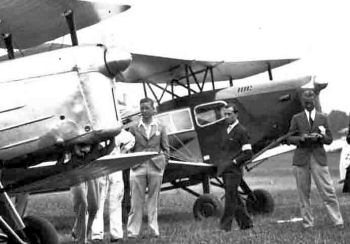
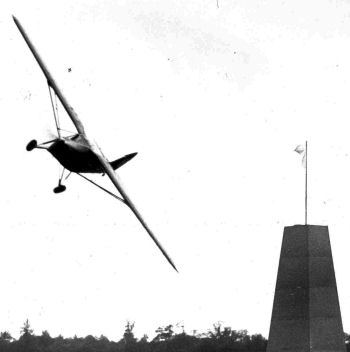
His real moment of glory was to co-pilot with Ken Waller the specially built D.H. Comet in the 1934 McRobertson England to Australia Centenary air race, in which they were awarded third prize in the Speed Handicap. On arrival they immediately turned round and flew back to England and established a record for the round trip.
Originally, he had teamed up with Miss Marsinah Neison in a Lockheed Altair (or Vega), "placed at their disposal by the builders", or possibly a Northrop Delta. However, nothing came of this.
He certainly wasn't first choice as Comet pilot - Bernard Rubin, the owner and intended pilot of the aeroplane, fell ill and originally nominated as substitute Mr Smirnoff 'the well-known Dutch pilot' on October 1st, and then only on October 5th (2 weeks before the race) 'finally and irrevocably' decided it should be Owen who accompanied Ken Waller. Three weeks before the Race, Owen had "never heard of Mr Rubin or Mr Waller", but apparently Marsinah said "Seajay, why don't you try and take Rubin's place?" Owen considered this a "most sporting action" on her part, but this meant that he had very little time to familiarise himself with the notoriously-tricky aeroplane.
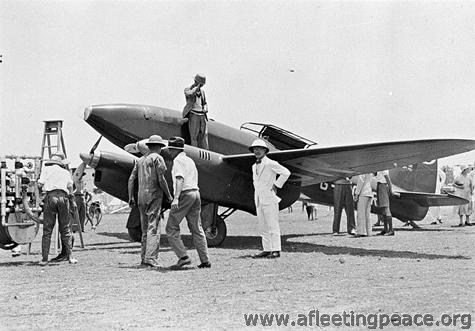
After the return trip from Australia, Owen said "We have averaged 10 hours' flying every day, and covered approximately 2,200 miles a day. We wanted to make this flight back not so much as a speed flight, but as a flight which could be copied for commercial purposes. We have flown only by day, and have had time to sleep, eat, and wash. From the commercial point of view I think there is no reason why there should not be a service between Melbourne and England on similar times to those we have taken, certainly for the carrying of mails.
People in the Colonies were very anxious to have their letters quickly and to have air-mail services covering the distance in so short a time. We had one nasty moment at Allahabad, when we had trouble with two of the cylinders, but the Mollisons came to the rescue and lent us spare parts - a very sporting action. We were greatly disappointed by the delay at Athens owing to bad weather conditions, which prevented us from getting to Lympne yesterday."
Messages of congratulations included this one: "The Duke of Gloucester directs me to congratulate you both on a magnificent double flight - Private Secretary, Duke of Gloucester.
However, even while he was away, the law was after him: "ENGLAND-AUSTRALIA AIR PILOT SUMMONED. Flight Lieutenant Owen Cathcart Jones, of the Naval and Military Club, Piccadilly. who is taking part in the air race to Australia, was summoned at Bow Street Court yesterday, on a charge of using a motor-car with an expired Road Fund licence. He did not appear, and on being informed that Lieutenant Jones was one of the competitors in the England-Australia race, Mr Dummett adjourned the summons sine die."
In 4 April 1935, several visitors arrived by air for the Norfolk and Norwich Annual Dinner, including " Lt. O. Cathcart-Jones and Miss M. Neison in a Puss Moth".
He published his "Aviation Memoirs" in 1935; "... breezy, light and interesting... the book is unusually well illustrated, with photographs which Mr. Cathcart Jones has collected or taken himself, and many of these photographs are extremely graphic and educative." Interestingly, Owen rather neglects to mention anything about his wife and children.
In 1935, Ken Waller got annoyed with him for something he said in this book that Ken felt "reflected on his courage and ability as a pilot", and even went to court over it. Owen replied that "that was the last thing he intended, as Mr. Waller and he had been, and still were, very good friends", which seemed to settle the matter.
Reading the memoirs, I can only assume this was the passage where, having got themselves lost in bad visibility over Arabia during the Race, Owen says that "little did I know that Ken was on the point of asking me to dive the machine into the ground and get it all over rather than face the possibility of running out of petrol, forced landing in the sand, where we certainly would have smashed the machine, and then lie there slowly dying without means of help."
In fact, Owen's is a rather bland account of their two-way trip, and at one point Owen credits Ken with a 'marvellous achievement'; "Ken, under great difficulties, made a superb landing".
Also in 1935, he drove a 4.5 litre Lagonda Rapide in the Monte Carlo Motor Rally, starting from Stavanger in Norway. He was the first competitor to arrive in Monte Carlo, and was thought to have a good chance of winning the first prize, but was eventually placed 34th. His 'second-in-command' was a Miss Marsinah Neison, "one of the very few women to hold a 'B' licence for aircraft".
Owen and Marsinah got up to quite a few things together:
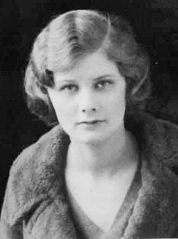
Beatrice Marsinah Neison, b. 3 Dec 1912 in Reigate. She gained her RAeC certificate at National Flying Services, Hanworth on the 11 Jan 1932, and passed the night-flying test in September.
Owen says of her "a young commercial pilot came to me for some advanced flying instructions, and I was very much impressed with the exceptional ability shown by her. Miss Marsinah Neison was the youngest girl pilot to get the coveted 'B' commercial pilot's licence. She qualified for it at the age of nineteen." He reckoned "there was very little I could teach her... I decided that her abilities were far too high to waste, and asked her to join me in any free-lance air charter work in which we could combine".
I'm not suggesting anything untoward, you understand...
In November 1933, she was trying to raise finance for a solo flight to Australia in a Comper Mouse, to beat the record held at the time by CTP Ulm, but never did.
Here she is, ready to go:
She sailed to California in May 1936, to visit her friend 'Russell Pratt', (sounds like an assumed name to me...) and to New York in July 1937. She married Hart Lyman Stebbins of New York 'very quietly' in London in December 1937, (they appear in the 'New York Social Register', whatever that means, for 1941), then Angus MacKinnon in July 1947. She died 29 April 1997 in Hampshire (England).
Anyway, Owen was by now pretty well-known; in May 1935, for example, he, Mrs Mollison (Amy Johnson), Tom Campbell Black, and other aviators took part in a 'Mock Trial', in aid of King Edward's Hospital Fund for London, at the London School of Economics; they were charged with 'Making the world too small'. The following August, he was chief pilot in the 'Jubilee Air Display', also with Tom Campbell Black.

 via Joss Mullinger
via Joss Mullinger"Lieut. Owen Cathcart-Jones and Mr. T. Campbell Black, two of the keenest rival prize-winning pilots in the great England-Australia Air Race last year, are combining in a brilliant partnership to take a leading part in the Jubilee Air Display which will be given at Home Farm, Tehidy, Camborne, Thursday, August 15th. 2.15 till dark. The display which is visiting no fewer than 180 centres throughout Great Britain during the summer months, has been specially planned to provide a striking demonstration of the supremacy of British modern commercial aircraft and the unrivalled skill of British pilots. Public interest in aviation has never been more keen than it is at the present moment."
Don't be fooled into thinking you might have flown in the D.H. Comet, though - Owen flew passengers in a four-seat G.A.L. Monospar, and Tom took them up in an Avro Cadet, a rather pedestrian trainer.
On 31 July 1935, Owen advertised, again in The Times: "Mr Owen Cathcart-Jones requires sponsor to finance building world's fastest commercial aeroplane for nine special long-distance record flights in 1936-7 showing profitable return."
Nothing came of this either...
By December that year, however, Owen was banned from flying in Argentina because of his 'stunts'near a military aerodrome; the following April, his aeroplane was impounded by the Austrian authorities and he had to make his own way back home via Cannes.
Gigi Jakobs tells me that "I came across his name in divorce proceedings for Robin W.G. Stephens and Phyllis Gwendlen (nee Townshend) Fletcher. They started divorce proceedings in late 1936 because, according to Stephens, his wife had committed adultery with Cathcart Jones from Dec 1935 to May 1936."
26 Jan 1937
"Owen Cathcart Jones, the well-known airman, of Grosvenor Street, London, failed to appear at his first meeting of creditors at the London Bankruptcy Court to-day. The assistant official receiver stated fhat the debtor had failed to surrender under the proceedings. A distress was levied at his flat last December, and goods sold in January. A representative of the petitioning creditor said that the debtor took an aeroplane to South America for demonstration purposes. The debtor sold the machine and failed to account for the proceedings, and a judgment for £660 had been obtained against him. Mr Newman said that the debtor in August last was alleged to have landed in Czechoslovakia with two Spanish Nationals, and subsequently disappeared. Whether he is in Spain or not I don't know." said Newman, "but I believe he was in this country December 22 last." The case was left the hands of the Official Receiver as trustee."
The bankrupcy hearing was first delayed, then postponed indefinitely; Owen didn't turn up for any of the meetings.
He somehow became an instructor at the London Air Park Flying Club at Hanworth, an elite government-subsidized club for wealthy patrons. His fellow-instructors included David Llewellyn and Ken Waller.
Five years later, he was, somehow, a Squadron Leader in the Royal Canadian Air Force:
"In March of 1942 he was posted to Western Air Command Headquarters, but nothing is recorded in the WAC HQ diary to confirm this or indicate duties. He was then ‘Posted to ABS’ (Absent), 29 April 1942. It appears that he had gone AWOL (Absent Without Leave), as the diary of Headquarters, Western Air Command, under date of 6 July 1942, read in part, ‘Squadron Leader O.Cathcart-Jones who has been AWL for some time, returned from California to this Headquarters under escort.’ He is then shown as taken on strength of Western Air Command Headquarters, 6 July 1942. Two months later, he was ‘Retired’ from the RCAF”.
Hugh Halliday fills in some background:
"He was living in Mexico City in April 1940 when he applied to the RCAF and was duly commissioned in that force on 16 May 1940 (Pilot Officer, simultaneous promotion to Flight Lieutenant). He was assigned to the Air Member for Operations and Training, AFHQ, and performed well enough that he was promoted to Squadron Leader, 1 June 1941. The timing of this suggests (but I cannot prove it) that he was advanced in rank to give him more credibility with American authorities.
In April 1941 he was sent to California on temporary duty as Special Advisor to Warner Brothers for the film “Captains of the Clouds”. The RCAF paid him a special allowance of $ 10.00 a day for the time he was there. He seems to have considered California a bit of a “hardship posting” because of high costs and a depreciated Canadian dollar. He nevertheless wrote to people at AFHQ (Ottawa) on Warner Brothers stationery, at one point urging that he not be forgotten when operational postings were distributed. As of 20 February 1942, Hal Wallis (Director of the film) was effusive in his praise of Cathcart-Jones both in production and publicity preparation. His services with Warner Brothers apparently ended that day.
On 4 March 1942 he reported back to the RCAF on posting to Western Air Command Headquarters (Victoria, British Columbia). About a month later he was advised that he was to be posted to Station Alliford Bay as Operations Officer. A remote station in the Queen Charlotte Islands, it might nevertheless have been deemed to be in a zone of potential intense operations, given the panic that had engulfed the West Coast following the opening of the Pacific War. Cathcart-Jones would have nothing to do with it. He pleaded personal difficulties – privately he stated that he regarded Alliford Bay as a backwater – and he argued for assignment to Seattle as a Liaison Officer. On 27 April 1942, Group Captain A.D. Hull (WAC Headquarters), having interviewed Cathcart-Jones, wrote, “Squadron Leader Cathcart-Jones has undoubtedly ability. However, he appears to put his personal affairs before the Service. Should be closely supervised on new posting and given an opportunity to prove his initiative and worth.”
The same day (27 April 1942) he was issued a travel warrant to travel from Victoria to Vancouver and thence to Alliford Bay. By then he had cleared out his Victoria apartment and disposed of his books. He took the boat to Vancouver. On 28 April 1942 he crossed the border into the United States, in uniform, stating that he was on RCAF duty to the Fourth Interception Command, and that he was waiting for orders from Ottawa. He then hastened on to Hollywood.
On 29 April 1942 he wrote to Western Air Command Headquarters, submitting a resignation from the RCAF. Since he was already a deserter, the “resignation” was not accepted. In June 1942 he was arrested by American authorities, charged with having made false and misleading statements on entering the United States. He sent a message to WAC, asking that confirmation be sent that he was in California on RCAF Liaison Duty. This, of course, could not be provided (one is struck by the man’s sheer cheek). He was returned under arrest to Canada, reporting back to WAC Headquarters, and his case reviewed in detail on the 9th. Among the issues disputed were his debts ($ 884.09) and whether he should be “retired” or be allowed to resign his commission (his preference). He was retired. It was deemed that a General Court Martial for an AWOL case was “over the top” – he just was not worth it. He had not been paid since the day he went AWOL."
During his time with the RCAF he designed a board game, for which he did all the artwork; he was then involved in The Movies (Technical Director, and a 30-second appearance as 'Chief Flying Instructor' in 'Captain of the Clouds', of which Flight said " it is a first-class production in almost every respect" ).
See the excellent article on Vintage Wings of Canada's website.
He then got mixed up in some tawdry goings-on with Errol Flynn and a Miss Peggy Satterlee..
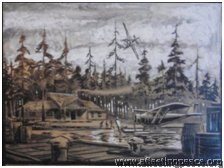
"This painting was done by Squadron Leader Owen Cathcart- Jones when he was an advisor on the movie 'Captains of the Clouds'. He also played a part in the movie. The painting shows the Hudsons Bay Co. trading post where the movie was filmed. When my father-in-law was ten years old, Cathcart-Jones gave him this lovely painting."
with thanks to http://relicsandtales.blogspot.com
He eventually bought a ranch to raise polo ponies, and became President of the Polo Club in Santa Barbara.
His daughter Imogen married John Otis Thayer (from Boston, Massachusetts) in September 1947. She was described as 'the daughter of Mrs A Cathcart-Jones of Wavedon, Bletchley, Buckinghamshire'.
Audrey died in 1962; her son Anthony in 2005.
In 1981, he wrote to 'Flight' "I had a bad accident at polo when I was knocked from my horse and fell on my head, but I am now almost completely recovered and back playing polo again."
Owen died February 1986, in California, aged 85.
Postscript
Imogen's son David actually met him: "Owen lived at 305 San Ysidro Rd., in Montecito. His ranch was about 4 acres at the end of a long driveway that passed through avocado orchards owned by the people who lived down on the road. It's been sub-divided and developed.
Some years ago, I walked up the driveway to discover that his house had been replaced by a large, pink, stucco hacienda and there's a second house, next-door, where his riding ring was. The avocado orchards down by San Ysidro Rd., are gone, too.Owen's sixth wife, and widow sold the place and moved to La Jolla a couple of years after he died. She died three or four years ago.
Imogen was reconnected with her father in the early 50s - he came to visit in 1952 and they wrote and phoned, after that.In the summer of 1965, my parents and their five kids drove out to Montecito, in a camper, and spent about a week at Owen's, just before he married his sixth ? wife, Pat, in August 1965.The following summer, 1966, I went out to visit him for two weeks, and was stranded in Montecito, for the whole summer, because of an airline mechanics strike which grounded the major airlines for 50+ days!It was great fun. My grandfather had to put me on the Continental Trailways bus, in September, to get me back to New York, in time for the first day of school.Owen had a second son, Colin, with his wife, Elizabeth Toomey, who he wooed away from her husband, in Buenos Aires, in 1936. She was married to a Mr. Waterman, who was, according to my grandfather's widow, Pat, the heir to the Waterman ink company. They married and had a son, in England, and came to NY soon after the boy was born. Evidently, in NY, he got involved with Marsinah Niesen, who was there and married to a Mr. Stebbins, and my grandfather walked out on Bette, leaving poor Bette to raise Colin in Queens, NY, with the help of her parents! She got no support from Owen.We have a January 1939 letter, from Colin's mother to my grandmother, Audrey, with her reaction to the news that Owen and my grandmother had not actually been divorced, though we do have a "Deed of Separation" which, I guess, is the precursor to divorce, in England.Bette Toomey Cathcart Jones had written to my grandmother for an affidavit of divorce so that she could proceed with her divorce from Owen. We have my grandmother's draft of the letter that she sent to Bette that prompted this response and my grandmotherher mentions Marsinah as one of the principals in her separation from Owen.Colin CJ died last January [2013]. We had Owen's passport with his and Bette Toomey's photos and Colin's name written in. I looked him up on the Internet and telephoned. We planned to meet but never got the chance. I spoke to him, just a year ago, on his birthday. November 13th." -
Cobham, Alan John
Mr (Sir) Alan John Cobham KBE AFC
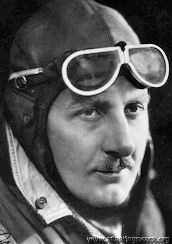 in c.1934, aged c.40
in c.1934, aged c.40
-
Cochran, Jacqueline
Jackie Cochran
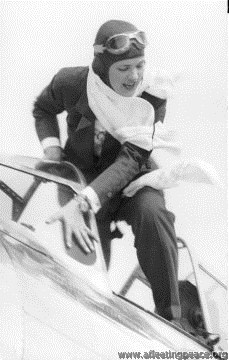
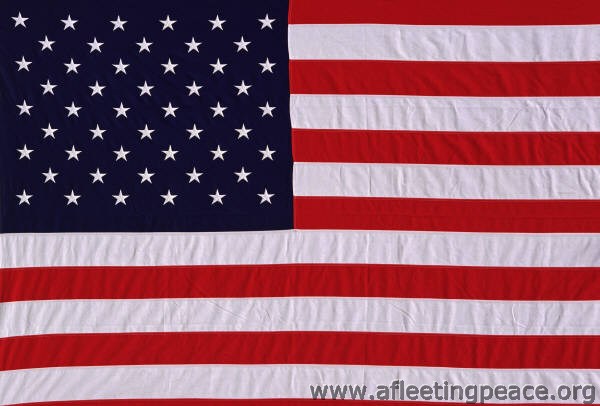 b. 11 May 1906 (as Bessie Lee Pittman) near Mobile, Alabama
b. 11 May 1906 (as Bessie Lee Pittman) near Mobile, Alabama"Jacqueline Cochran's earliest memories are of life with a foster family on what she called "Sawdust Road," but what was, in fact, a lumber mill town in northern Florida. In her autobiography she remembered having no shoes until she was eight years old, sleeping on a pallet on the floor and wearing dresses made of cast-off flour sacks. As a child she was hired by a beauty shop owner, and by the time she was 13, she was cutting hair professionally. In the 1920s she became one of the first women to master the newly invented permanent wave. But one of the customers, noting Cochran's spark, encouraged her to do something more serious with her life. With very little formal education, Cochran enrolled in nursing school.
Even though Cochran completed three years of training to be a nurse, she never quite adjusted to the profession. In her autobiography, she remembers not ever getting "comfortable with the sight of blood." She constantly had to resist the urge to hand in her notice, reminding herself that a nurse was more valuable than a beautician. But she was never convinced, and an experience delivering a baby to an impoverished mother in Florida helped drive her back to the beauty trade. She remembered three children were sleeping on pallets next to the woman giving birth. "There I was with neither the strength nor the money to do the smallest fraction of what needed to be done to make those lives better... . In a beauty shop the customers always came in looking for a lift. And unless I really screwed up," she concluded, "they left with that lift."
Her next job as a beautician at Antoine's in New York's Saks Fifth Avenue brought Cochran into her future husband's world. At a dinner in 1932, the dashing millionaire financier Floyd Bostwick Odlum advised Cochran that if she were ever to realize her dream of setting up her own cosmetics firm, she'd need wings to cover enough territory to beat her competition. Cochran took the advice to heart, and that summer she learned to fly. "At that moment, when I paid for my first lesson," Cochran remembered later, "a beauty operator ceased to exist and an aviator was born."
Macrobertson Air Race in 1934
Excerpt from: "JACKIE COCHRAN, An Autobiography" by Jacqueline Cochran & Maryann Bucknum Brinley
"Gee Bee stands for Granville Brothers, a Springfield, Massachusetts, airplane company which made fast, unstable, dangerous planes in the thirties. The nearly cute nickname is a sham. They were killers. There were few pilots who flew Gee Bees and then lived to talk about it. Jimmy Doolittle was one. I was another.
I tell you all this as a prelude to my story about the London-to-Australia race. I flew a Gee Bee, the QED Gee Bee, but a Gee Bee nonetheless. The QED was Latin for "Quod Erat Demonstrandum" and came from the designers who translated that as "Quite Easily Done." It was not easily done, however. The crazy QED violated basic rules of aerodynamics.
Clyde Pangborn had entered his name in the race, hoping to find himself in a Gee Bee but, because of problems at the factory as well as an offer from Roscoe Turner, who had never flown over oceans before and knew that Clyde had, the QED was still sitting in the hangar, almost ready to go. Clyde had joined Roscoe's team but was still the registered owner of an entry.
He had the official right to name an alternate crew, and I knew it. Sitting in New York, after my conversation with Royal, searching for a way to stay in the race, I remembered Clyde's QED and made all the right calls.
Granville Brothers knew me because I myself had approached them earlier in the game but had changed my mind when I compared it with the chance to be in a Northrop. Jack's planes were so streamlined and beautifully fast for their day.
But any plane was better than no plane. I bought the Gee Bee with a little help from my friend Mabel Willebrandt. Granville Brothers were pleased because they were anxious to make a name for themselves in such a prestigious international contest. They even offered to send mechanics along to complete the plane en route to London on the ship.
In the meantime, I had Wesley Smith and Royal Leonard take some of the sophisticated equipment out of the Northrop Gamma so we could install it in our Gee Bee.
We had four hours to make the official arrangements with the London officials. I needed what was called an airworthiness certificate, numerous permissions to fly over all those countries, not in a Gamma but a Gee Bee, and Mabel turned on the steam. Mable even convinced a Department of Commerce official to go along on the boat to do the necessary testing.
Landing lights, flares, radio equipment - we planned to install as much as we could as we crossed the Atlantic, in spite of storms and seasickness. Not much would get done as it turned out.
All this was done by telephone. I never set eyes on that Gee Bee until I arrived at the airport near Southampton, England, and tried to fly it to the field where the race would commence, twenty-four hours later. It was a disaster and still incomplete. The other disastrous aspect was the tremendous publicity surrounding the contestants. I had never experienced anything like it. I never sought publicity like that in my life because mostly it's a waste of your time. And I didn't like the scene there in London one bit.
The press kept rumoring about the mysterious American woman entry, but there was nothing mysterious about my whereabouts or doings. I had a tricky, incomplete plane to contend with. In the meantime, Clyde Pangborn was giving me trouble and demanding that I pay him for the transfer of his entry. After all the anguish that Gee Bee had caused me - at that point I had no idea my troubles were just beginning - he had some nerve asking for money.
I was furious. And I told him so. If I had been a man, we would have gone out behind the hangar to fight it out....
The starting point the next morning was a nearly-completed Royal Air Force base at Mildenhall, sixty miles north of London. The lord mayor of London was there promptly at 6:30 am to drop the official white flags. Planes took off at 45-second intervals, and the famous team of Mollisons - Amy was a wonderful pilot and flew with her husband - were first. Wesley and I were fourth in line and had been warming up the engine, but as soon as we were airborne, the plane sort of staggered, dipped slightly, and I knew we were in for a real ride.
Neither of us knew that Gee Bee well enough. We recovered speed, however, and we were serious about sticking with it.
The haze was horrible and I was happy Wesley had been such a nag about my instrument training and Morse code lessons. This race, however, was actually the first and last time I relied on Morse code.
After all the hullabaloo in America about this contest, only three American-crewed entries remained: Roscoe Turner, the United States speed king at the time; Jack Wright, a stunt pilot from Utica, New York; and me. When you compared the elaborate preparations I had made for the flight - sending specialists ahead on the route with automatic refueling devices, flares, spare parts, personal items, extra instruments - as well as the whole debacle with my Northrop Gamma - to Jack Wright's simplistic attitude, I really wondered.
All Jack wanted to do en route was to "fly this plane while it's still mine". It was a tiny Lambert Monocoupe with a single 90 horsepower that hummed along. Who had more sense: him or me?
I had even sent clothes along to Melbourne so I'd have something to wear to the festivities.
But I wasn't alone with my big thinking. Roscoe Turner had gone into hock to buy a Boeing transport plane he called the "Nip and Tuck". Then because of rough weather he hadn't been able to get it off the ship at Plymouth. They had to take it over to France, to Le Havre, where the French tried to make him pay import duty of $20,000. He got around that but had to unload the plane, assemble it, and fly it back to England in time.
That was funny about all of our best-laid plans was that the Europeans had been sullen and some of them openly angry about what they believed to be a Yankee conspiracy to walk away with all the prize money.
Little did they realize. My Gee Bee was the fastest plane in the race, I believe, but right from the start I realized that it wouldn't be speed that would win.
Jackie and her co-pilot Wesley Smith were forced down by engine trouble in Rumania.
In 1953 she became the first woman to break the sound barrier in a F-86 Sabre jet fighter, earning the title 'America's Fastest Lady'.
d. 9th August 1980 in Indio, California, aged 74
-
Cotton, Frederick Sidney
Flt-Lt Frederick Sidney Cotton OBE
 in 1920
in 1920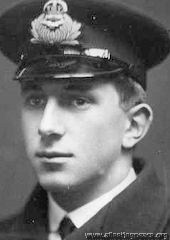
in 1916, when a Flt Sub-Lt in the RNAS
b. 17 June 1894 in Bowen, Queensland, Australia
RNAS in WWI; he invented the 'Sidcot' flying suit, which was standard issue in the RAF until the 1950s.
There was a curious period in early 1920 when four sets of people tried to fly from Cairo to Cape Town; not for any particular prize or competition, but just because they fancied being the first to do it. Frederick Cotton and his engineer Capt W A Townsend flew a DH.14a and were the least successful of the lot, making a forced landing in southern Italy and writing off the machine before they even got to Cairo.
In the winter of 1920-21 he and Alan Butler were in Newfoundland, "doing some extremely useful work surveying, spotting for seals, etc", and the following September they both competed in the Croydon Aviation Meeting.
In late 1922 he had "exciting times" in flying from Newfoundland to the newly-discovered gold fields at Labrador. He then settled into being a pilot in Newfoundland, although he came back to England occasionally, for example for the 'Portsmouth Trophy Race' round the Isle of Wight in 1934, in which he came second.
Married 3 times, clever, sometimes quite rich (although he died penniless) and rather, er, "unorthodox" (bleedin' awkward, by the sounds of it), he spent WWII as an unofficial advisor to the Admiralty, especially involved with photographic reconnaisance and airborne searchlights.
d. 13 Feb 1969 in London
-
Drew, Donald Herbert
Donald Herbert Drew AFC 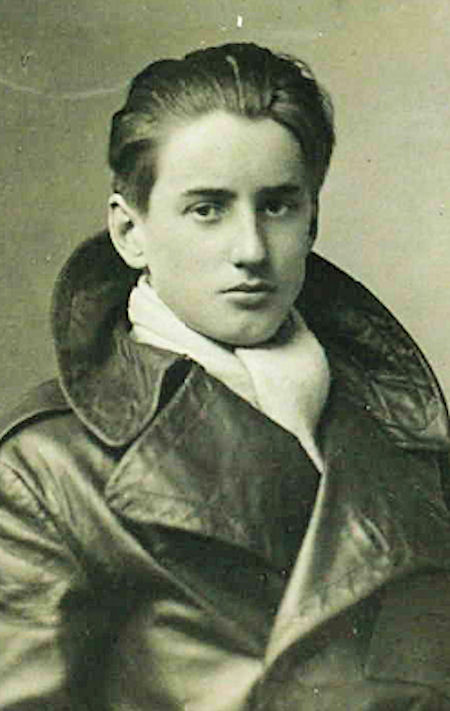
in 1917
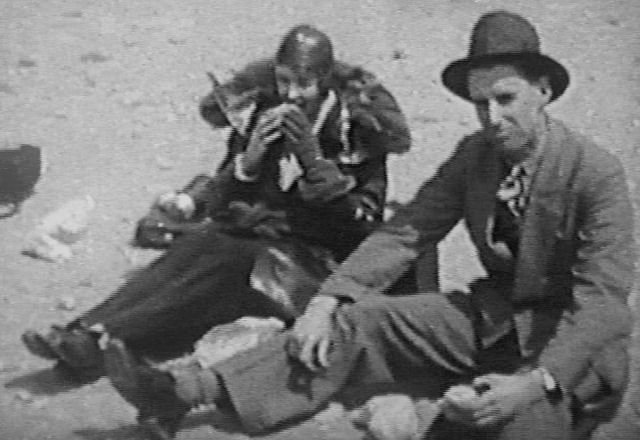
with Adelaide Cleaver in 1929
b. London 23 Sep 1899
'Aeroplane and Seaplane pilot'
2 July 1930: "AIR PILOT DIVORCED. JUDGE'S COMMENTS ON CO-RESPONDENT. A decree nisi, with costs and custody of the child, was granted in the Divorce Court yesterday to Mrs Arabella Beatrice Angela Drew, who gave her address at the Stafford Hotel, St James's Place, London. She had petitioned for the dissolution of her marriage to Captain Donald Herbert Drew, of the Aerodrome Hotel, Croydon, on the ground of his alleged adultery with Mrs Kathleen Brookie Digby, who offered to write her address, but said she had no permanent home.
Captain Drew, an Imperial Airways pilot, was in charge of the aeroplane from which Captain Loewenstein, the Belgian financier, disappeared over the Channel.
The suit was defended, and Captain Drew and Mrs Digby gave evidence denying the allegation.
Mr Justice Hill, giving judgment, said that there was evidence that Mrs Digby entertained flying officers at the house and that they went there for tea or cocktails. It was obvious from the evidence that Mrs Digby was a woman who was quite capable of committing adultery with Captain Drew or, indeed, he thought, with anybody else."
He married again, a year later:
9 June 1931: "ROMANTIC MEETING IN AIRPLANE. NOTED ACTRESS AND PILOT TO MARRY.
Miss Betty Eley, the musical comedy actress, who played the part of Lady Mary in " The Vagabond King " at the Winter Garden Theatre, London, has become engaged to Captain Donald Drew, the noted air pilot. Miss Norah Blaney, who was also one of the principals in " The Vagabond King " arranged a tea party in an airplane about four years ago, and Captain Drew piloted the machine over London while the party was in progress. Miss Eley was one of the guests, and she and Captain Drew became friends. About 15 months ago Miss Eley went out to Australia, where she appeared in "Hold Everything," and "Love Lies." She returned to England about six months ago. Miss Eley said to-day: "We shall not be married for some time, as my fiancé will be away for three months."
d. 1936: "Capt. Donald Drew, for some years an Imperial Airways pilot, died in London today after a long illness at the age of 36.
Capt. Drew was piloting Capt. Lowenstein's private plane when the Belgian millionaire fell from it into the Channel on July 4. 1928. When Capt. Lowenstein offered him a position as a pilot he would not take it until Imperial Airways agreed to lend him to the 'Lowenstein Navy', as the financier's air fleet was called."
Wierdly, Lowenstein's biographer, a Mr Norris, in 1987 "concluded that Lowenstein had been thrown from the aircraft by Donald Drew, the pilot, at the behest of Madeleine Lowenstein, the motive being to gain control of Lowenstein's fortune. He suggested that the aircraft's rear door was completely removed while in the air and a replacement fitted on the beach at St. Pol."
-
Hawker, Harry George
Mr Harry George Hawker MBE, AFC 
in 1912, aged 23

b. 22 Jan 1889 in Victoria, Australia; son of a blacksmith, and the co-founder of Hawker Aircraft.
A very early flier - RAeC Certificate No 297, in 1912. The following year, he made 5 flights 'on and off water' in a Sopwith-designed seaplane, which meant that they won the £500 offered by the RAeC.
An even bigger prize in 1913 was the £5,000 offered by the Daily Mail for a race for seaplanes, to cover nearly 1600 miles in 72 hours round the coast of Britain. Harry (with fellow Australian H Kauper as mechanic) started off in a Sopwith from Southampton on August 16th. They got as far as Yarmouth but Harry felt unwell (later they worked out that he had sunstroke) and had to return to Southampton for another try, which started on the 26th.
Unfortunately, having made good progress on their first day, nearing Dublin on the second his foot slipped off the rudder bar, the aeroplane fell "like a stone" and dumped them in the Irish Sea, whence they had to be rescued by the Coastguard; the machine was wrecked. Harry was unhurt, Mr Kauper injured. The Daily Mail gave them a consolation prize of £1,000 "in recognition of their plucky attempt".
A few weeks later, he wrote off another Sopwith at Brooklands, badly injuring his back. The following year he did it again in almost the same place, this time failing to control a loop and spinning down into some trees. When spectators reached the scene, Harry was standing by the smashed aeroplane, "bewildered but unhurt".
Nothing daunted, he broke the British altitude record by climbing to 18,393ft in 1915, although it took him over an hour and he" suffered greatly from the cold"; he then broke the world record by getting to 24,408ft on 26 April 1916 (which started people wondering about perhaps flying to the top of Everest).
Next, in 1919, the Daily Mail offered £10,000 for a flight across the Atlantic. Harry, with Commander Kenneth Mackenzie Grieve R.N. as navigator, started from Newfoundland on 18th May but the aeroplane had problems with its radiator and they had to put down in the sea after about 800 miles. It was several days before the news emerged that they had been rescued by the small steamer 'Mary', and taken to Thurso. The Nation, having feared the worst, was mightily relieved, and gave them a terrific welcome; "No event since the Armistice has so stirred the popular imagination". Harry and Kenneth got the Air Froce Cross each (despite the fact that Harry wasn't actually in the Air Force), and £2,500 each as a not-inconsiderable consolation prize (although they had agreed to split the original prize 70:30). Before they could try again (on June 15th to be precise), Alcock and Brown had done it (just), been knighted by Mr Churchill and walked off with the cheque for £10k. Damn!
His luck finally ran out when he was killed in the Nieuport Goshawk G-EASK which crashed at Hendon 12 July 1921 while he was preparing for that year's Aerial Derby. The aeroplane burst into flames and spun in; Harry leapt from (or fell out of) the plane and was found some distance from its remains, "quite dead".
-
Hinchliffe, Walter George Raymond
Mr Walter George Raymond 'Hinch' Hinchliffe 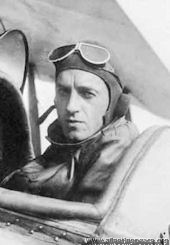 1916
1916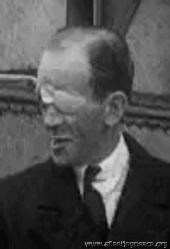 in 1927
in 1927b. 10, or 11 Jun 1893, or 1894
WWI fighter pilot (7 victories, the last of which cost him his left eye); he then became a well-known pilot for Daimler Air Express, which formed part of Imperial Airways in April 1924.
On 18 December 1924 he flew G-EBBX, a D.H.34 single-engine airliner, from Croydon to Amsterdam but, after setting off on the return journey, the engine oil pressure started fluctuating alarmingly and he turned back; the engine was overhauled, and he tried again, with the same result. Again, the engine was overhauled and tested thoroughly and they finally got back to Croydon on Christmas Eve, although the engine was still running rather roughly.
The next person to fly the aeroplane was David Stewart; the aeroplane took off from Croydon later the same day and crashed within a few minutes, killing him and his 7 passengers. It was the first fatal crash suffered by Imperial Airways, and it led to the first Public Enquiry into a civil aircraft accident in the UK.
Hinch carried on as one of Imperial Airways' senior pilots; two years later, for example, he flew Geoffrey and Mrs de Havilland, plus another man and four other women, to India, to inaugurate Imperial Airways' Egypt-India Empire service.
September 1925: "AIR PILOT'S RECORDS. COVERED HALF A MILLION MILES. Two world's records for length of time spent in the air and distance flown were created by Mr W. R. Hinchcliffe, the Imperial Airways pilot, who, when he arrived at the London Air Station, piloting a Napier D.H. express from Amsterdam, on Saturday completed 6000 hours' flying.
Mr Hinchcliffe has been flying continually for more than nine years, and, taking an average speed for the numerous different types of airplanes he has flown, has covered more than half a million miles by air. In flying this distance he has spent the equivalent of 250 entire days, or more than eight months, in the air."
October 1926: "AEROPLANE BLOWN BACKWARDS CAUGHT BY STRONG WIND AND CARRIED FOR MILE. Captain W. G. R Hiinchliffe, the Imperial Airways pilot, had the unique experience of travelling backwards through the air yesterday while testing one of the big Rolls-Royce air liners at Croydon Aerodrome. Ascending to a height of 2000 feet, he encountered a head wind so strong that his machine was blown steadily backwards for a distance of over a mile."
He came 4th in the King's Cup in July 1927.
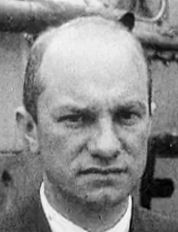 Then in August 1927 he was asked by wealthy American businessman Charles A Levine to try an east-west trans-Atlantic flight in the Bellanca monoplane NX237 'Miss Columbia'.
Then in August 1927 he was asked by wealthy American businessman Charles A Levine to try an east-west trans-Atlantic flight in the Bellanca monoplane NX237 'Miss Columbia'. Clarence Chamberlin had set the world long-distance record flying from New York to (near) Berlin in this aeroplane, with Levine as passenger; indeed, they had missed being the very first 'long' trans-Atlantic flight by only a few days.
Clarence Chamberlin had set the world long-distance record flying from New York to (near) Berlin in this aeroplane, with Levine as passenger; indeed, they had missed being the very first 'long' trans-Atlantic flight by only a few days.However, this idea was abandoned after Leslie Hamilton, Lt-Col Minchin and Princess Lowenstein-Wertheim disappeared in their Fokker FVIIa G-EBTQ when they tried the same thing. Instead, they decided to try to break the long-distance record by flying to India, but only got as far as Vienna when oil pressure fluctuation (again!) and bad weather forced them to land.
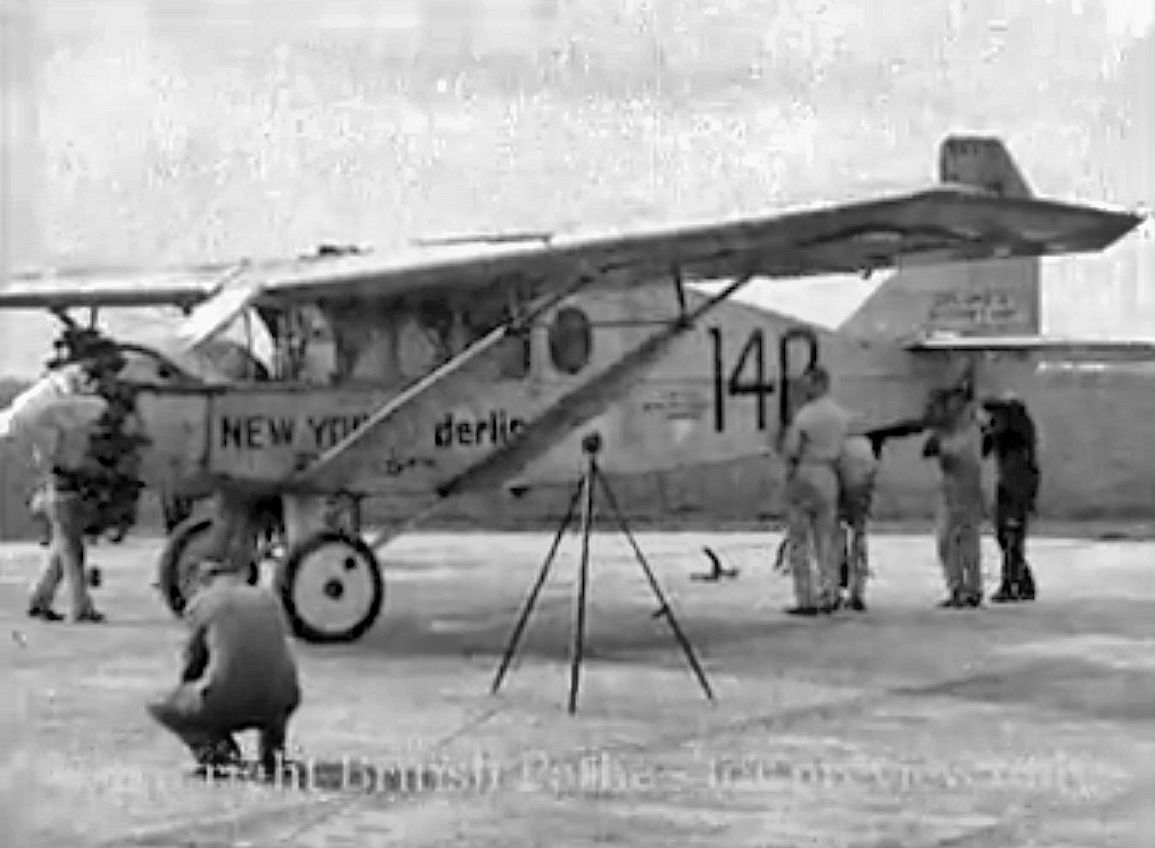
There is some footage of the preparations at Cranwell for this flight, (and of the Fokker 'St Raphael' in which Hamilton, Minchin and Princess L-W lost their lives) here: https://www.britishpathe.com/video/old-flying-stories/query/Levine
So (Hinch having already agreed a month's leave from Imperial Airways) they then took a leisurely flight round Italy, including an audience with the Pope on 3 October; the Pope gave Mr Levine the apostolic benediction, "blessing his future enterprises". The next day, however, intending to drop a present for Signor Mussolini's new baby boy, they had to make a forced landing in a vineyard, doing serious damage to the aeroplane but luckily not themselves.
The Bellanca was repaired but later destroyed in a hangar fire; another one, painted to look like it, was in the Virginia Aviation Museum.
'Hinch' disappeared with Elsie Mackay in 1928 trying to cross the Atlantic from east to west.
Elsie's parents, Lord and Lady Inchcape, generously put Elsie's £521,101 13s 4d in trust for the nation for about 50 years, after which time they hoped it "should be used to reduce the National Debt". They also gave Capt Hinchliffe's widow Emilie (sometimes known as Eileen) £10,000, his estate being a rather more modest £32.
-
Löwenstein-Wertheim-Freudenberg, Princess Anne of
Princess Anne of Löwenstein-Wertheim-Freudenberg (Lady Anne Saville) 
25 May 1864 – 31 Aug 1927)
She was the second woman both to attemptand to perish in a transatlantic aircraft flight.
She owned the 1927 Fokker F.VIIa, G-EBTQ 'St Raphael' which was lost over the Atlantic in August 1927, with Leslie Hamilton and Fred Minchin.
-
Markham, Beryl
Beryl Markham 
b. Beryl Clutterbuck 26 October 1902 in Rutland but moved to 'British East Africa' (Kenya) when she was 4.
Married three times; the second of these was to Mansfield Markham in 1927, although she was briefly engaged to the Hon. Robert Fraser Watson, later of the ATA:
see https://www.ata-ferry-pilots.org/index.php/category-blog-1941/1141-watson-robert-fraser
"A serial story with the facts set down, but with all the explanations provocatively left out, has been running since Friday of last week in newspaper columns. It is a disappointing story in one way, for the last chapter leaves the reader with an unsatisfied middle-chapter curiosity.
The first instalment appeared on Friday 22 April 1927. Here it is:— “The Hon. R. F. Watson and Mrs. Purves. “The engagement is announced between the Hon. Robert Fraser Watson, second son of the late Lord Manton and Claire Lady Manton, of Offchurch, Bury, Leamington Spa, and Beryl, only daughter of Mr, C. B. Clutterbuck, late of Njoro, Kenya Colony, and of Mrs Kirkpatrick, of Sey, Kenya Colony.”
Tuesday's instalment (23 August) brought a complication, for it announced that “the marriage arranged between the Hon. R. F. Watson and Mrs. B. Purves will now not take place.”
The serial concluded yesterday, only three days later, with the announcement :— “Mr. M. Markham and Mrs. Purves. “The engagement is announced from Kenya Colony between Mansfield Markham, second son of the late Sir Arthur Markham, Bt., and Beryl, only daughter of the late Mr, C. B. Cluttterbuck and Mrs. Kirkpatrick, of kenya Colony.”.
Began flying in 1931, but it wasn't until 1936 that she made headlines by being the first person to fly solo from England to North America. Her autobiography, West with the Night, sold over a million copies.
d. 3 August 1986, aged 83
-
Stack, Thomas Neville
Capt Thomas Neville Stack 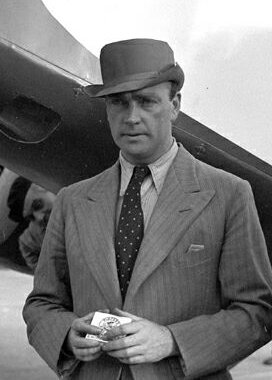 1934, aged 38
1934, aged 38
RAeC [0312-0087]
b. 1 April 1896; universally known as 'Stacko'
RFC in WWI, then became a familiar figure in aviation circles during the 1920s - in 1926 he and Bernard Leete made the first flight from England to India in two DH. Moths, one of several record-breaking flights.
He and J R Chaplin tried to fly to Australia and back in 1931, but had to turn back at Constantinople, Turkey, with carburettor trouble; later in the year the same pair attempted a flight to India and back, but again turned back with mechanical problems.
He was appointed 'Air Superintendent' of Iraq Airwork Ltd in 1933, and flew their first machine (a Spartan Cruiser) there via Cairo in 1933. Shortly afterwards, he flew 2 doctors and a nurse out to India, to perform an urgent operation on a Nepalese princess.
Late 1933 found him testing the Airspeed Courier - which is probably where he met Sydney Turner - and was widely expected to fly it in the MacRobertson Race. A month before the race, he broke (his own) London-Copenhagen record in a Miles Hawk, which is perhaps why he was too busy to inspect the Viceroy properly....
He turned up for the MacRobertson Race looking very tired and drawn - Alan Goodfellow described him as looking 'over-trained, physically', and Neville Shute Norway said he was "an exhausted and a worried man".
Shortly after the race, he was appointed Air Superintendent and Manager of Hillman's Airways; after that became part of British Airways he spent time in Turkey, advising them on civil aviation.
He was killed when run over by a lorry in Karachi, India on 22nd February 1949, aged 52. At first, the Karachi Police said he had committed suicide but, while agreeing that he was 'on the verge of a nervous breakdown', the inquiry decided that the cause of death was actually an aneurism of the aorta, and he would have died anyway.
Neville was "always very good company. He was never happier than when singing a song and strumming on his banjo."
-
Stodart, David Edmund
Sqn-Ldr David Edmund Stodart DSO  1934
1934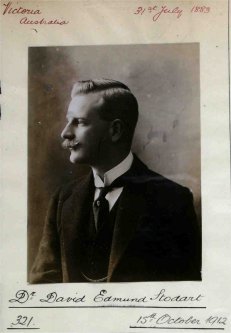 1912
1912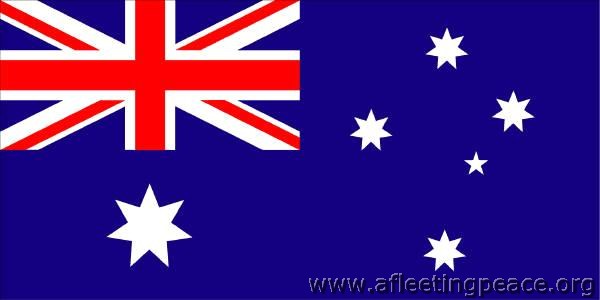 Born 31st July 1882, in Gobur, Victoria, Australia, eldest of seven children.
Born 31st July 1882, in Gobur, Victoria, Australia, eldest of seven children.Went to Edinburgh to study medicine; a very early aviator (RAeC Certificate No 321, in 1912); pre-WWI racer in England as 'Dr Edmund'. Mentioned in dispatches three times during WWI, promoted eventually to Major, he was awarded the DFC and later the DSO.
Post-WWI, RAF Squadron Leader in the Middle East:
"Cobham to go on
Successor to Shot Airman Chosen
Airmen have been searching for two days to trace the Arab sniper who shot Mr. A. B. Elliot, the air mechanic, who was accompanying Mr. Alan Cobharn on his flight to Australia and back.
Accompanied by Squadron-Leader David E. Stodart, D.S.0., of the Shaibah Iraq Bombing Squadron, Mr. Cobham flew back to Nasiryah yesterday.
Mr. Cobham is to continue his flight. The Havilland Aircraft Company is sending Mr. Moore, of the Armstrong Siddeley firm, to take the place of Mr. Elliot" - Daily Herald - Friday 09 July 1926
...then back to Middlesex Hospital as a physician in the dermatology department.
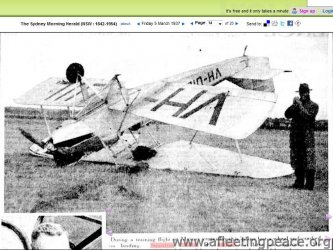
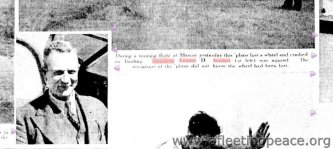
![MacRobertson Race 1934 K4047 Airspeed Courier (David Stodart) [0822-0032]](/images/gallery/air%20races/MacRobertson/preview/333s333/MacRobertson%20Race%201934%20K4047%20Airspeed%20Courier%20%28David%20Stodart%29%20%5B0822-0032%5D.jpg)
Oldest and 'most casual' competitor in the MacRobertson Race, but the first Australian to reach Melbourne. He and Kenneth should have won one of the handicap prizes - possibly even the First Prize - but mistakes in the handicapping system robbed them of the glory they deserved, not to mention the cash.
After the Race, he stayed on in Australia for a while, mostly working as a flying instructor, then finally came back to England, where he died 26th February 1938 in Brighton, aged 55:
"LONDON. February 28
The death has occurred of Squadron-Leader David Edmund Stodart, who, owing to the Incapacitatlon of all the officers in his detachment in war time, did the work of an entire squadron for three weeks, Including the administration of bombing. observing and photographing.Stodart. when 52, was sixth In the Melbourne air race In 1934."p.s. the £2,000 for the Handicap Race prize would be worth about £400,000 today...might have been useful, considering that David's estate when he died was £157.
-
Tribe, Mary du Caurroy (The Duchess of Bedford)
Mary du Caurroy Tribe, Duchess of Bedford
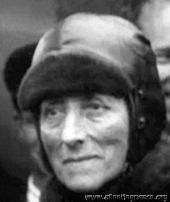
b. Mary du Caurroy Tribe in 1865 in Stockbridge Hants, the second daughter of the Rev. W H Tribe; he later became Archdeacon of Lahore and (after growing up in Sussex, where she and her elder sister Zoe were looked after by their uncle and aunt), she lived there for several years. It was in Lahore that she met, and married, Lord Herbrand Russell, who in 1888 became the 11th Duke of Bedford. She was probably best known as an aviator, but had several other strings to her bow; she was a member of the Society of Radiographers, and was "interested in natural history, especially ornithology". To prove this, she once shot 200 pheasants in a day and (although presumably not the same day) caught 18 salmon weighing 200lb.
Actually, she wrote scientific papers on ornithology, and was a member of the British Ornitholgists' Union.
She was deaf (I'm not sure if this was always true, or if it developed later on in life).
During WWI, Woburn Abbey was turned into a hospital and every morning the Duchess would "go on duty at 5 or 6am, and in her nurse's dress would assist at nearly every operation." The King was pleased to award her the 'Royal Red Cross, in recognition of her valuable nursing services', in Jan 1918.
Her personal pilots included C D Barnard, James Allen and (from 1934) R C Preston, but she herself learned to fly in 1933.
Dame Mary from 1928.
She owned:
a 1927 DH.60X Moth, G-EBRI;
the 1927 Fokker F.VIIa, G-EBTS, 'The Spider', in which she broke the England-Cape Town record in 1930;
a 1928 DH.60G Gipsy Moth (G-AAAO);
later she owned
a 1931 DH.80A Puss Moth, G-ABOC, later sold in Kenya,
a 1932 DH.60G Gipsy Moth, G-ABXR,
a 1933 GAL ST.4 Monospar 2 G-ACKT, registered in October, in which her personal pilot, James Bernard Allen, was killed in December 1933, and finally
a 1934 D.H.60G Moth G-ACUR in which she flew out over the North Sea in March 1937...
... and disappeared.

